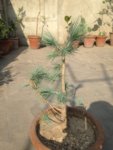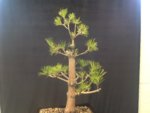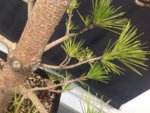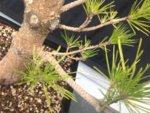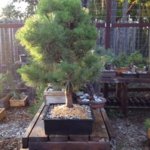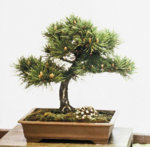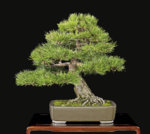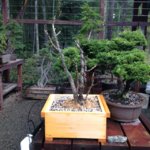I noticed you repotted it into an Anderson flat, wish I could find those out east without having to buy a bunch and ship them across county. I just cobble together wooden boxes. Anyway, how did you handle the roots? HBR, or just comb them out and keep as much as possible? What mix did you use? I generally use a pumice and hadite mix with varying amounts of bark chips. I was thinking of repotting mine next spring but may wait until late summer as that would be almost a one year rest period since I did the intial pruning. I have yet to pull it out of the nursry pot for a look see but given the heavy foliar growth I bet it is full of roots. BTW, since it ws 65 F today I got busy and snipped off all but two terminal buds on each branch. I want to limit supression of back budding as much as possible. Wish I had snipped them when I bought the tree as it might have made a few buds then. Hopefully I’ll get a bunch of back buds this coming year and then in spring 2020 there with be a massive flush of new growth.
As usual the approach i used was dictated by what i found. This tree had been slip potted up a size several years ago. So the center was congested with old soil and lots of tangled roots in the core. The outside circle was compacted and circling the large container but not as congested. The bottom was sparsely populated with roots. The soil was mostly perlite, peatmoss, sand and fir bark. That is typical for most nurseries in this area.
The first thing i did was remove the bottom half of the root ball with an old saw. I then excavated the center core upwards and inwards, removing large roots and old soil. Next i combed out the sides of old soil and cut back most roots, removing old and or all dead material as well as the nursery mix. The end result was a smaller compact root ball with the old soil removed underneath in the centre.
I prepared the anderson flat with approximately 3/4 inch deep drainage layer of coarse pumice, then added my usual Bonsai mix for pines, mounding some in the centre to fill the excavated area under the root ball. Used bamboo sticks in either side of the root ball for anchoring , the wire which i brought up through the bottom grid then tied down each side. next carefully worked the soil between exposed roots and settled the soil into the container. Thorough watering to wash out any remaining fines and thoroughly water initially. Back in the sun and wait 3 or 4 weeks for root recovery before fertilizing.
My usual mix is 1 part black lava, 2 parts pumice, 1 part granite and 1 part akadama. All components are sifted and similar in particle size. The drainage layer is slightly larger particle pumice but not a big enough difference to create issues with drainage and water retention. Anderson flats do not have feet and the extra drainage layer is important unless they are elevated in some way. Mine always sit on a bench with air spaced between slats or on a gravel bed that allows air movement in the bottom.
With this approach the next repot will be a 1/2 HBR, and the following repot will complete the change out of the remaining nursery soil. I typically choose this approach on nursery stock to allow me to continue developing the tree while also working on repotting and developing the root ball. Particularity with older nursery stock. I do not use this approach with Hemlock or Spruce. Rather a slower approach with them, more segmented and taking an extra repot or two to complete the change out. The highest priority in my mind is the centre core from underneath as it usually hides the most chronic root issues in common nursery stock due to the regular slip pot routine often used.

